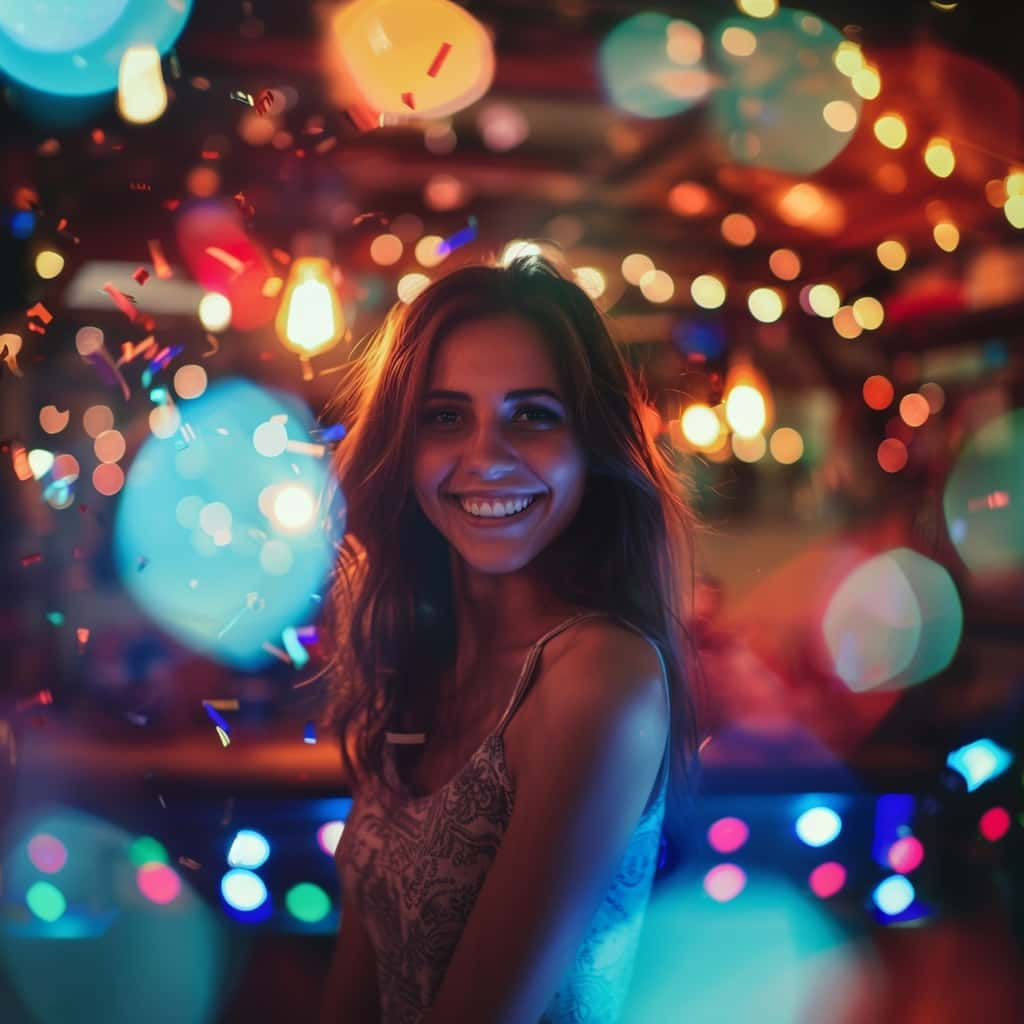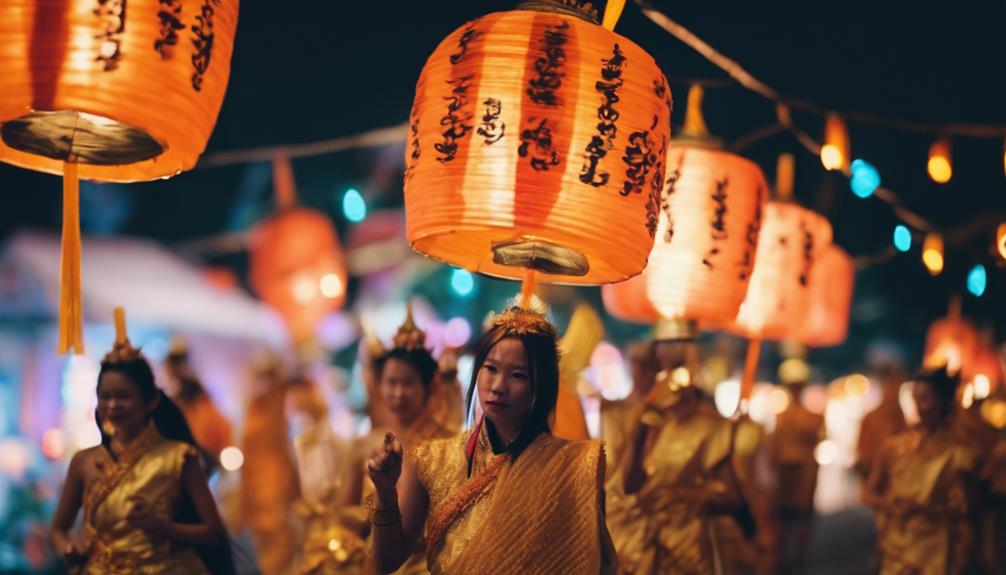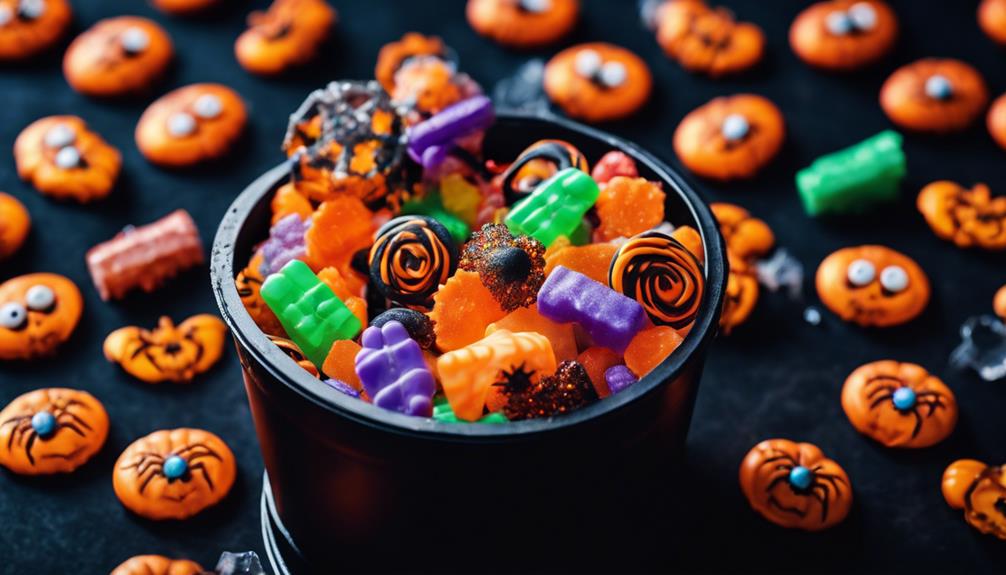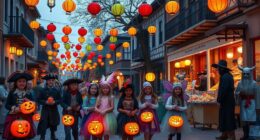When designing vampires, werewolves, and witches, you draw on ancient roots of myth that reflect fears of death, disease, and the supernatural. Visual elements like fanged faces, sharp features, and dark, Gothic colors help convey their dangerous allure. Cultural influences shape their appearances and powers, from primal transformations to mystical spells. Understanding these origins and symbols can deepen your designs, and if you keep exploring, you’ll uncover even more secrets behind these iconic monsters.
Key Takeaways
- Incorporate cultural origins and symbolism to create authentic vampire, werewolf, and witch designs rooted in myth and legend.
- Use distinctive facial features, color schemes, and iconography to emphasize each monster’s unique traits and thematic elements.
- Highlight transformative and mystical powers, reflecting inner conflict, primal instincts, and magical abilities in visual design.
- Draw inspiration from historical practices and evolving folklore to develop complex, relatable, and culturally rich monster characters.
- Blend traditional motifs with modern media influences to craft innovative, immersive, and emotionally resonant monster portrayals.
Origins and Evolution of Vampire Mythology

Vampire mythology has deep roots that stretch back centuries, evolving from ancient fears and cultural beliefs. These stories often symbolized fears of disease, death, and the unknown. Over time, vampire symbolism shifted, reflecting societal anxieties about morality, mortality, and the supernatural. In Eastern Europe, legends of revenants and blood-drinkers laid the groundwork for modern vampires, while Western folklore added elements like undead immortality and nocturnal habits. As myths traveled and transformed, vampires became more than just frightening figures; they embodied cultural fears about death, the afterlife, and the boundaries between life and death. This evolution shaped the complex vampire archetype we recognize today. Additionally, the cultural transmission of vampire stories across different societies contributed to the diversity and richness of the myth, influencing contemporary portrayals in literature and media.
Visual and Symbolic Elements of the Vampire Design
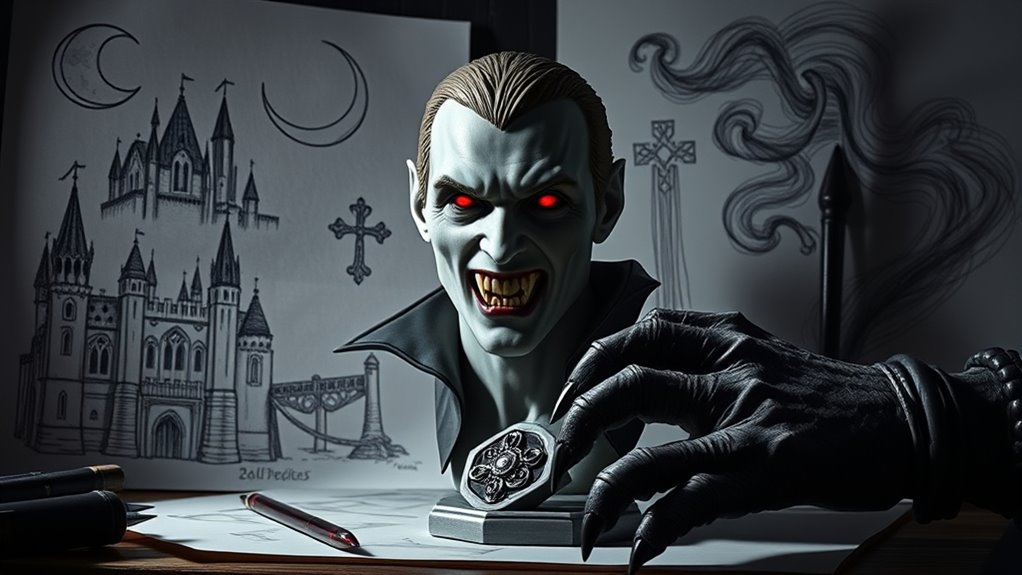
Vampires often feature fanged facial features that emphasize their predatory nature and dangerous allure. Their dark, Gothic colors create a mysterious, ominous atmosphere that reflects their supernatural origins. These visual elements work together to symbolize both their menace and their timeless, eerie presence. Additionally, Inspirational Quotes about fatherhood can serve as a metaphor for understanding the enduring and protective aspects of vampire lore.
Fanged Facial Features
Fanged facial features are a defining visual element that instantly signals a creature’s predatory nature. Your focus should be on sharp, prominent fangs paired with intense facial expressions that convey hunger or menace. The jawline and cheekbone design emphasize the creature’s strength and ferocity, framing the face with angular precision. To evoke a sense of danger and allure, consider these elements:
- Long, pointed fangs peeking from slightly parted lips
- Facial expressions that reveal aggression or seduction
- A jawline that’s strong and sharply defined
- Cheekbones that add a sculpted, almost predatory contour
- Fangs that appear ready to strike at any moment
These features combine to create a vampire face that’s both alluring and terrifying, emphasizing its predatory essence with every glance. Incorporating facial anatomy into your design can help enhance the realism and impact of the features.
Dark, Gothic Colors
To reinforce the creature’s predatory nature, designers often rely on dark, Gothic colors that evoke mystery, danger, and allure. Deep blacks, blood reds, and shadowy purples dominate the palette, creating a sense of enigma and menace. Imagine a vampire lurking in moonlit forests, where the interplay of darkness and faint moonlight enhances their sinister presence. These colors also highlight enchanted artifacts, emphasizing their mystical power and ancient origins. The contrast between shadow and subtle highlights draws attention to sharp features and elegant garments, reinforcing a sense of timeless elegance intertwined with danger. By using Gothic hues strategically, you evoke the eerie atmosphere surrounding vampires, making them both alluring and formidable in your design. Incorporating color symbolism can further deepen the emotional impact and thematic resonance of your vampire imagery.
The Transformative Power of Werewolf Imagery
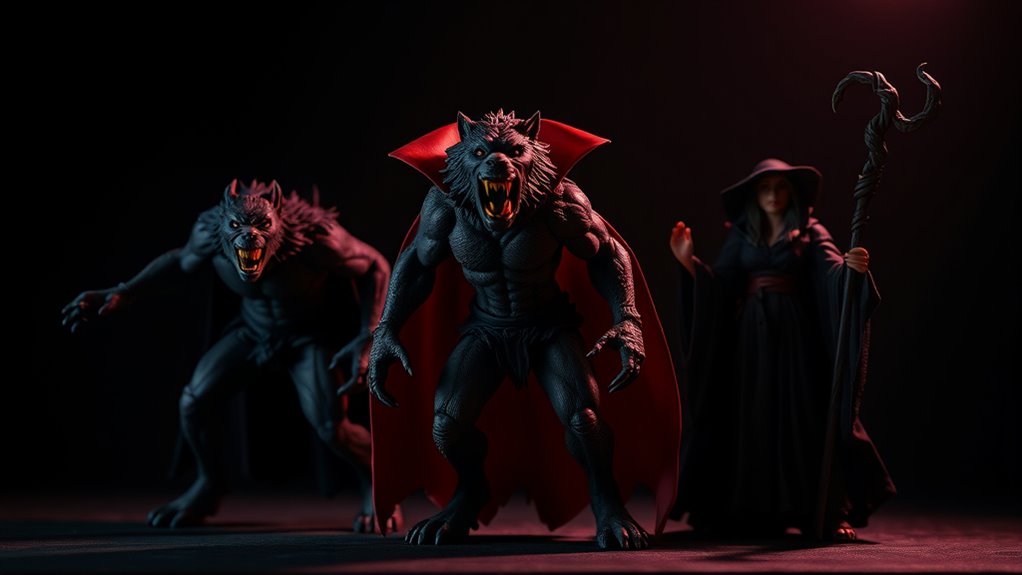
Werewolf imagery possesses a remarkable ability to symbolize transformation and inner conflict, tapping into deep-seated fears and desires. Through lycanthropy symbolism, you see a creature caught between humanity and beast, embodying primal instincts and suppressed emotions. The werewolf transformation captures this struggle vividly:
- Bones cracking as muscles swell and reshape
- Fur erupting across skin in wild patches
- Eyes glowing with feral intensity
- Claws extending with deadly precision
- The moon’s glow illuminating a fierce, untamed face
This imagery vividly reflects the chaos of change, reminding you that beneath civility lies a wild core. The werewolf transformation becomes a powerful metaphor for personal upheaval, forcing you to confront the animal within and the duality of human nature. Incorporating mindfulness practices can help navigate these intense feelings of transformation and inner conflict, fostering greater self-awareness and emotional balance.
Crafting the Mystique of the Modern Werewolf
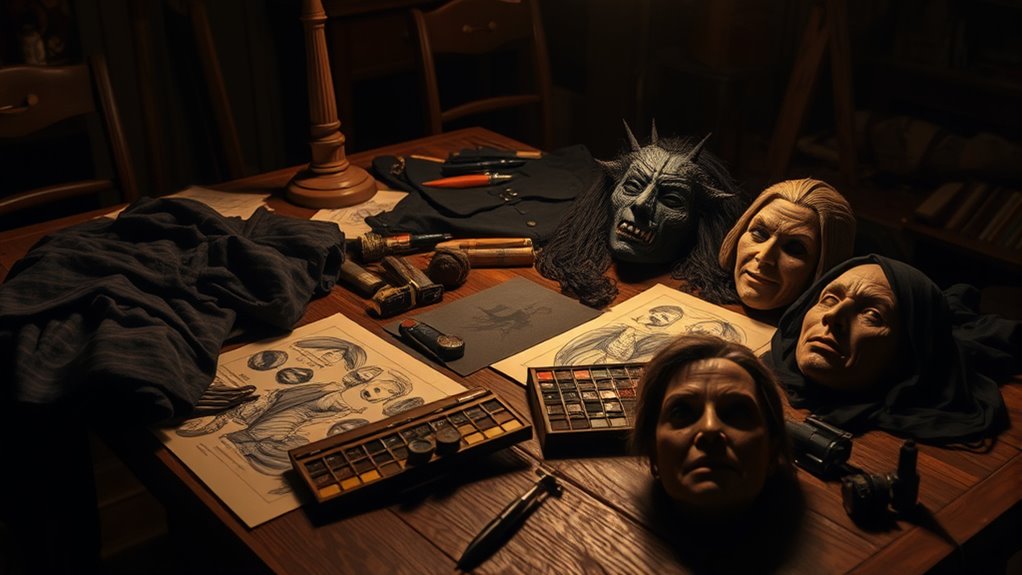
In crafting the mystique of the modern werewolf, creators blend timeless symbolism with contemporary themes to evoke both fear and fascination. You highlight moonlit transformations, emphasizing the eerie beauty of the full moon triggering primal instincts. This duality connects ancient fears with modern vulnerabilities, making the creature both relatable and terrifying. To visualize these ideas, consider this table:
| Element | Symbolism | Impact |
|---|---|---|
| Moonlit transformations | The cycle of change, chaos | Instills awe and dread |
| Primal instincts | Innate animalistic drives | Emphasizes raw, uncontrollable power |
| Humanity vs beast | Inner conflict, dual nature | Creates depth and relatability |
| Fear of loss of control | Vulnerability in chaos | Evokes suspense and empathy |
This approach keeps the werewolf relevant, blending myth with modern psychological themes. Additionally, understanding Arcade Machine technology can inspire creative storytelling elements by integrating nostalgic gaming motifs into character design and narrative development.
Witchcraft Through the Ages: From Folklore to Fantasy
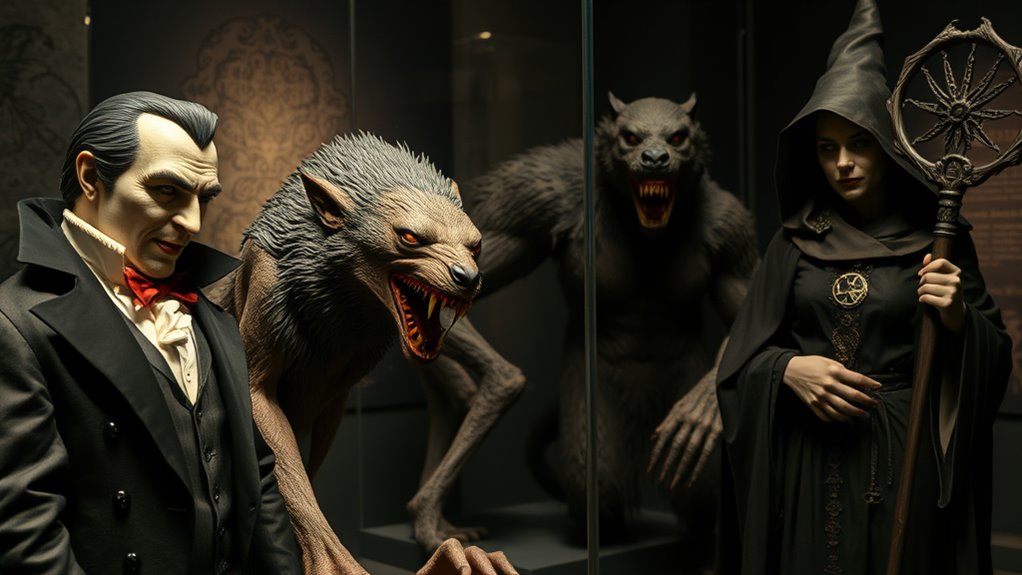
Witchcraft has evolved from ancient folklore practices to a prominent theme in modern fantasy stories. You can see how historical beliefs, like potion-making and spells, influence today’s fictional depictions of witches. Exploring this shift reveals how perceptions of witchcraft shape both history and imagination. Additionally, the portrayal of witchcraft in popular culture often draws inspiration from folk traditions and legends, blending myth with modern storytelling techniques.
Historical Witchcraft Practices
Throughout history, people believed that certain individuals possessed supernatural powers and used them to influence events or cause harm. These practitioners, often called witches, engaged in ancient rituals to harness unseen forces. You might imagine them gathering under moonlit skies, lighting candles, and chanting incantations. Potion brewing was a key part of their craft, mixing herbs and mystical ingredients to heal or curse. Their practices included:
- Drawing symbols in the dirt or on parchment
- Burning herbs to ward off evil spirits
- Anointing objects with oils or blood
- Using charms and talismans to protect or attack
- Performing secret ceremonies in hidden locations
These acts created an aura of mystery and fear, fueling legends and accusations that would shape perceptions of witchcraft for centuries. Incorporating sound vibrations into rituals was also believed to enhance their effectiveness and establish a connection to unseen energies.
Modern Fantasy Depictions
As stories about witches evolved from ancient rituals into modern fantasy, authors and filmmakers began reimagining their powers and appearances to captivate audiences. Drawing from medieval folklore and mythological origins, they transformed traditional witchcraft into dynamic characters with unique abilities. Instead of the old hag or crone stereotypes, modern depictions often showcase witches as powerful, complex figures—sometimes as heroes, sometimes as villains. You’ll see magical skills rooted in folklore, like spellcasting, potion-making, and shape-shifting, but with creative twists. These portrayals emphasize personal empowerment and mysticism, blending historical mythos with contemporary imagination. This evolution keeps witch characters fresh, relatable, and intriguing, allowing audiences to explore the rich, layered history of witchcraft through a modern fantasy lens. Additionally, contemporary depictions often incorporate modern media influences, creating more diverse and multidimensional characters that resonate with today’s audiences.
Iconography and Attire: How Witches Are Portrayed
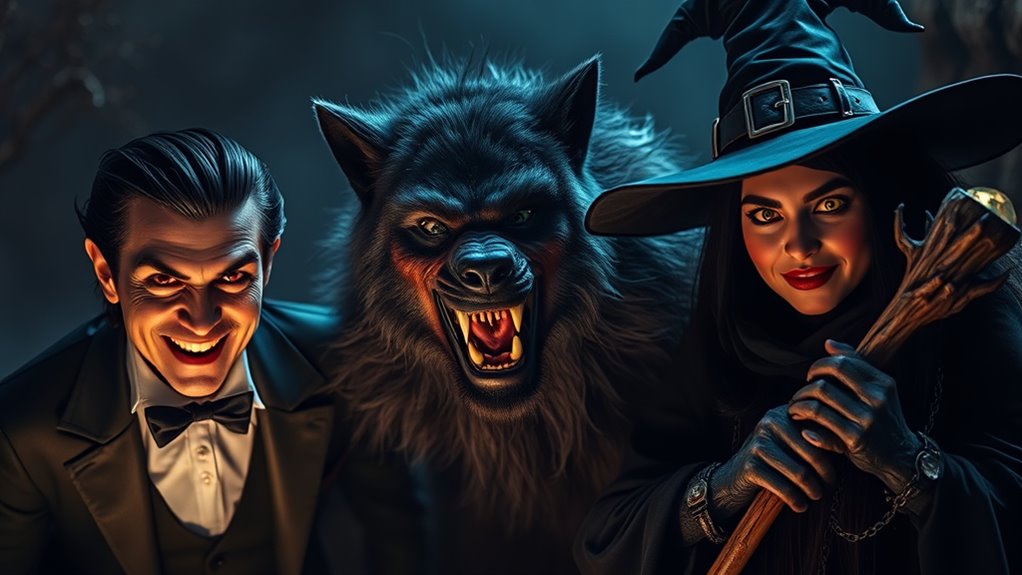
Iconography and attire play a crucial role in shaping how witches are portrayed in popular culture. You often see them with pointed hats, flowing robes, and mystical accessories that emphasize their supernatural aura. Symbols like cauldrons and broomstick motifs are central to their identity, representing their craft and flight. Their clothing often features dark colors, lace, and layered fabrics to evoke mystery and power. Accessories such as spell books, potion vials, and talismans deepen the mystical image. The cauldron symbolizes transformation and potion-making, while broomsticks suggest mobility and independence. These visual elements create a recognizable archetype, blending tradition with fantasy, instantly conveying the witch’s role as a powerful, enigmatic figure in storytelling and media.
Cultural Influences and Variations in Monster Depictions
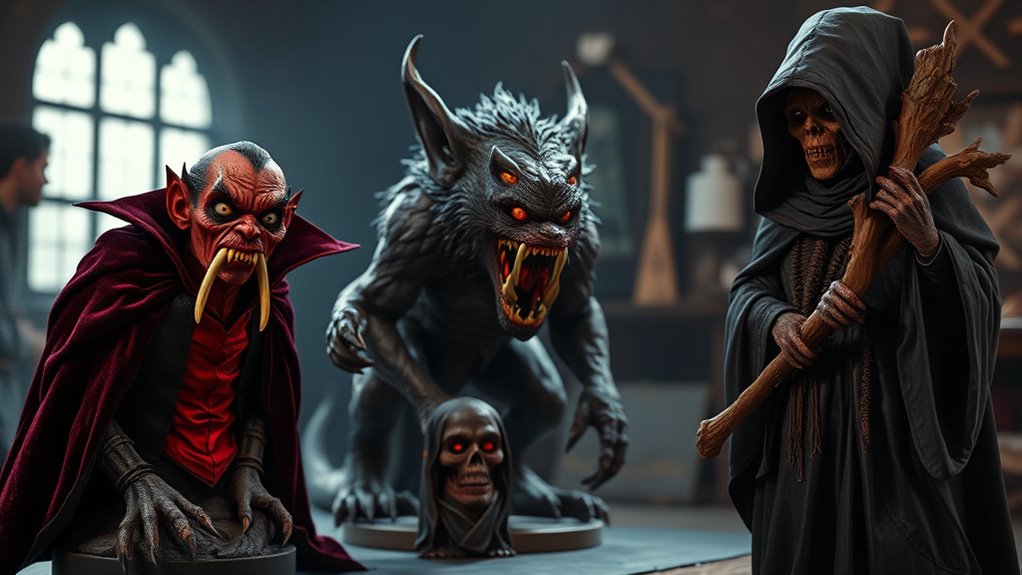
Different cultures shape their own unique visions of monsters, reflecting local beliefs, fears, and values. These creatures often embody cultural symbolism, serving as moral lessons or warnings rooted in regional stories. For example, European vampires emphasize themes of death and immortality, while Asian folklore features spirits and demons with specific moral lessons. Regional adaptations influence their appearance, powers, and behaviors, making each monster distinct. In some cultures, monsters symbolize societal anxieties; in others, they reflect spiritual beliefs. The visual representations of monsters are also influenced by cultural contexts, shaping how they are portrayed in stories and media. Recognizing these differences allows you to appreciate how diverse societies interpret fear and morality through their unique depictions of monsters.
Contemporary Innovations in Monster Characterization

Contemporary creators are reshaping monster characterization by blending traditional themes with modern perspectives, resulting in more complex and relatable creatures. They draw inspiration from urban legends, transforming familiar fears into nuanced narratives, and incorporate mythological symbolism to deepen their meaning. These monsters often embody societal anxieties or personal struggles, making them resonate on a human level. Imagine:
- A vampire haunted by its past instead of just craving blood
- A werewolf struggling with identity amidst urban chaos
- Witches depicted as empowering figures fighting oppression
- Creatures that blur the line between hero and villain
- Mythological symbols used to evoke ancient fears and wisdom
This innovative approach invites you to see monsters not just as threats, but as reflections of real-world conflicts, emotions, and myths, enriching their storytelling depth. Additionally, digital revolutions are enabling creators to craft more immersive and interactive monster narratives, engaging audiences in new ways.
Frequently Asked Questions
How Do Cultural Differences Influence Vampire Character Design?
Cultural differences greatly shape vampire character design by influencing their symbolism and folklore origins. You notice that in Western cultures, vampires often embody fear and immortality, while in Asian traditions, they might symbolize spirits or ancestors. You can incorporate these cultural nuances into your designs, using specific symbols, attire, or traits that reflect local folklore, making your vampire characters more authentic and resonant with diverse audiences.
What Are the Psychological Effects of Monster Imagery on Audiences?
Ever wondered how monster imagery impacts you? It induces fear, triggering your primal instincts, but it also fosters empathy as you connect with characters’ vulnerabilities. This dual effect sharpens your emotional awareness, making stories more immersive. Do you realize that these images can help you confront your fears safely and develop empathy for others? Ultimately, they serve as powerful tools for emotional growth and understanding through fear induction and empathy development.
How Do Modern Media Reinterpret Traditional Witchcraft Symbols?
Modern media reinterpret traditional witchcraft symbols through fresh symbolism reinterpretation, blending historical elements with contemporary themes. You’ll notice a shift in visual language, making symbols like broomsticks, cauldrons, and pentagrams more stylized or subversive. This evolution reflects current cultural narratives, empowering or questioning old stereotypes. By doing so, media transforms these symbols into versatile storytelling tools that resonate with today’s audiences, blending mysticism with modern symbolism reinterpretation.
What Role Does Gender Play in Monster Character Aesthetics?
Gender influences monster character aesthetics by reinforcing or challenging stereotypes through aesthetic symbolism. You see, designers often emphasize traits like strength or seduction aligned with traditional gender roles. You can choose to subvert these stereotypes by blending elements, making monsters more complex and nuanced. This approach allows you to explore gender identity more freely, creating characters that challenge conventional expectations and add depth to the monster’s visual storytelling.
How Are Technological Advances Shaping Contemporary Monster Creation?
You’re witnessing a new frontier where technology breathes life into monsters, transforming them into living, breathing nightmares. Holographic illusions create illusions so real, they blur the line between fantasy and reality. Bioengineered monsters push the boundaries of biology, giving rise to creatures once confined to nightmares. These advances allow creators to craft more terrifying, immersive experiences, making you question what’s real and what’s a digital illusion.
Conclusion
So, next time you see a vampire sipping blood, a werewolf howling at the moon, or a witch casting spells, remember—they’re just costumes for our fears and fantasies. We love to dress up monsters to hide our truths, pretending they’re all just stories. But deep down, maybe we’re the real monsters—afraid of change, craving power, or just bored. After all, what’s scarier than facing ourselves in the mirror?

